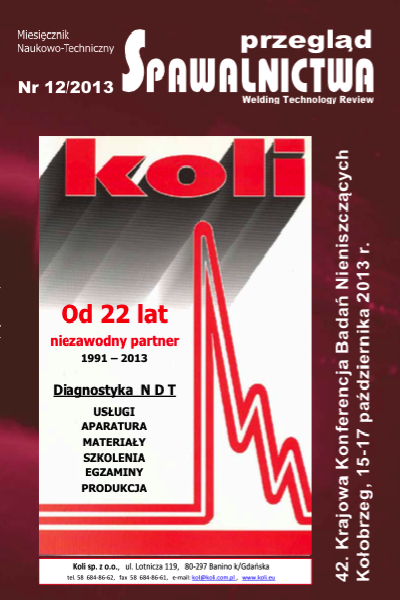Ocena dekohezji łopatki turbiny gazowej metodą tomografii komputerowej
Main Article Content
Abstract
W procesie eksploatacji lotniczych silników turbinowych podstawową metodą diagnozowania stanu łopatek wirnikowych jest metoda wizualna (wideoendoskopowa), a wyniki potwierdza się badaniami metalograficznymi, metodą niszczącą. W artykule omówiono metodę rentgenowską tomografię komputerową (CT) oraz możliwości jej stosowania do diagnozowania zmian stanu łopatek turbin gazowych, jako metodę badań nieniszczących (nDT). Tomografia jest transmisyjną techniką diagnostyczną umożliwiającą uzyskiwanie warstwowych obrazów detalu. Jest ona wykorzystywana w laboratoriach naukowo-badawczych i stosowana w procesie kontroli jakości produkcji. W artykule przedstawiono wyniki badań oceny stanu eksploatowanych łopatek turbiny gazowej metodą wizualną oraz rentgenowską tomografią komputerową. Wyniki te zweryfikowano badaniami metodą metalograficzną. Stwierdzono, że metoda radiograficzna, wygenerowując przestrzenny obraz wnętrza łopatek, umożliwia rozpoznanie rodzaju wad, ich wielkości i umiejscowienia. Ponadto zaprezentowano możliwości techniczne tomografu V/tome/x m o mocy lampy 300 kV oraz możliwości obróbki danych w programie do rekonstrukcji VG Studio Max2. Równolegle prowadzone są prace z lampą do nanotomografii o mocy 180 kV i rozdzielczości do 0,5 μm, szczególnie przydatną do badań materiałów kompozytowych.
Evaluation of the decohesion effect on gas turbine blades with use of computer tomography
abstract
The basic diagnostic method usually applied to assess technical condition of rotor blades is the visual inspection carried out with use of a video endoscope. The outcome of such an inspection is validated by means of destructive tests by investigation of metallographic polished specimen. This paper outlines the innovative technique of Computer Tomography (CT) and presents its applicability and diag- nostic advantages when the method is used for non-De- structive Tests (nDT) aimed at determination how much blades of gas turbines are deteriorated due to the effect of the operational environment.
The method is used by research and scientific labora- tories as well as in other fields, including quality control at manufacturing plants.
The paper compares results for evaluation of technical condition demonstrated by gas turbine blades and acquired from visual inspections against the ones from investigations by means of Computer Tomography. Finally, the results were validated by investigation of metallographic microsections. It was found out that the X-ray method is capable of produc- ing 3D images for inner spaces of blades and thus enables identification of defect types, their sizes and locations. In addition, the paper presents technical performances of the V/tome/x m tomography with the X-ray tube for 300 kV voltage and capabilities of the VG Studio Max2 software designed for reconstructions of images. In parallel, investigations with the use of a tube for nanotomography for the voltage of 180 kV and resolution of 0.5 μm are also in progress since that type of tube is particularly useful for investigation of composite materials.
Downloads
Article Details
Creative Commons CC BY 4.0 https://creativecommons.org/licenses/by/4.0/
Welding Technology Review (WTR) articles are published open access under a CC BY licence (Creative Commons Attribution 4.0 International licence). The CC BY licence is the most open licence available and considered the industry 'gold standard' for open access; it is also preferred by many funders. This licence allows readers to copy and redistribute the material in any medium or format, and to alter, transform, or build upon the material, including for commercial use, providing the original author is credited.
References
Lewitowicz J.: Podstawy Eksploatacji Statków Powietrznych-Badania Eksploatacyjne Statków Powietrznych; T. 4., ITWL Warszawa 2007.
Szczepanik R., Rządkowski R.: A study on the dynamics of aero engine blades under different operating conditions; ITWL, 2012.
Błachnio J., Spychała J., Pawlak, W., Kułaszka A.: Assessment of
technical condition demonstrated by gas turbine blades by processing of images for their surfaces;Journal of KOnBIn 1 (21) 2013, s.41-50.
Materiały z firmy YXLOn International GmbH.
Lindstedt P.: Parametryczna metoda diagnozowania łopatki pracującej maszyny wirnikowej z eliminacją niemierzalnych czynników otoczenia; Problemy badań i eksploatacji techniki lotniczej. Tom 8; ITWL, 2012.
